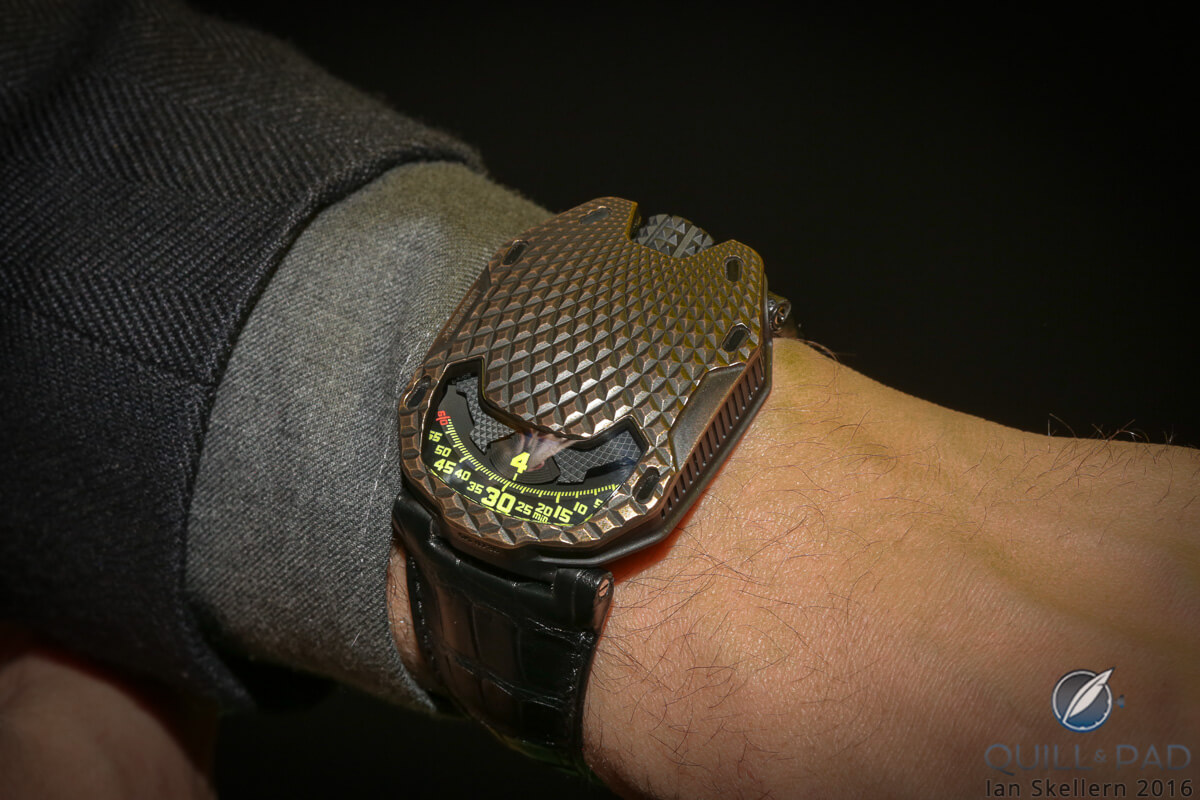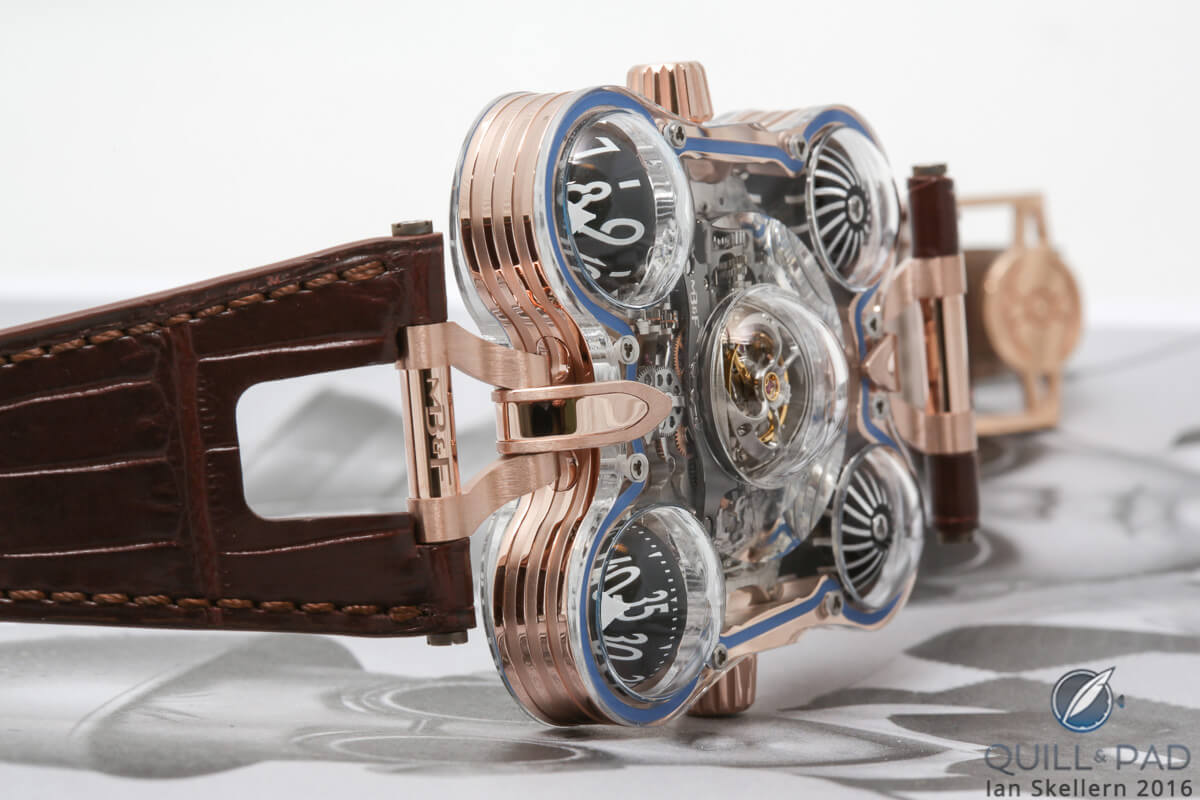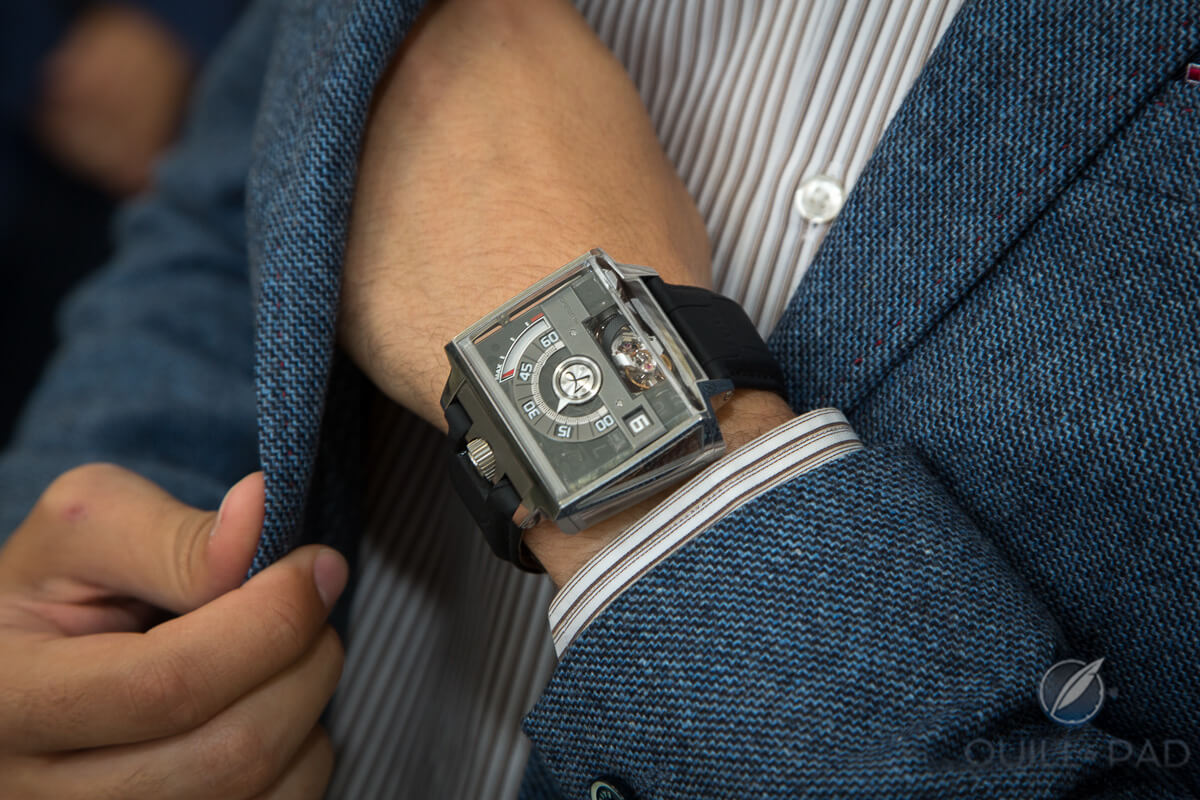by Ian Skellern
Once through check-in, coat check, security, and badge scan, the SIHH is a comforting cocoon. Yes, the visitor is likely to have an extremely hectic schedule, but that’s a personal thing: the SIHH itself is a relatively relaxing environment, especially compared to Baselworld.
And for return visitors there is the comfort of knowing where all of the brands are as the SIHH evolves slowly and any changes from year to year are usually minor and infrequent.
But 2016 heralded a fairly major seismic shift: out went Ralph Lauren and in its place appeared the Carré des Horlogers, an exhibition space within the SIHH devoted to nine smaller independent brands.
The disappearance of Ralph Lauren at the SIHH highlighted just how difficult developing a successful high-end watch brand is, even with the budget and marketing clout of two of the biggest players in luxury retailing, Ralph Lauren and the Richemont Group.
All post-SIHH reports indicate that the inclusion of the so-called indies was a big success for both visitors and the small brands alike, but that there was a little grumbling from some of the larger, established SIHH brands generated by the fact that visitors to the fair may have remarked − with justification − that there were more interesting watches in the Carré des Horlogers than in the rest of the SIHH altogether.
Yes, many SIHH-invited journalists and retailers were discovering the nine smallish brands for the first time, so for them the watches were completely new, but by any measure the Carré des Horlogers had an extremely high level of exciting watches per square meter.
What does the composition of the Carré des Horlogers brands mean?
Here are the small brands who exhibited at the 2016 SIHH Carré des Horlogers in alphabetical order:
Christophe Claret
De Bethune
Hautlence
H. Moser & Cie
HYT
Laurent Ferrier
MB&F
Urwerk
(Kari) Voutilainen
But now lets list them by what I will term “traditional” and “contemporary” status.
Traditional brands are those making predominantly fairly traditional watches, i.e. timepieces with central hands, round cases, and classic complications.
Contemporary brands comprise those with unusually shaped cases and/or non-traditional indications and complications.
*Please note that when I refer to “brands” in this article, I am always referring to “high-end” brands.
Traditional brands
H. Moser & Cie
Laurent Ferrier
(Kari) Voutilainen
Contemporary brands
Christophe Claret
De Bethune
Hautlence
HYT
MB&F
Urwerk
The first thing we see is that contemporary brands outnumber traditional brands two to one.
Now assuming that when the FHH/SIHH was selecting which haute horlogerie independent brands to offer a space they had no bias as to whether traditional or contemporary, then we can extrapolate − admittedly from an small sample size − that there are twice as many high-end contemporary independents than traditional independents that:
1. Have been in business long enough to reassure the SIHH that they are likely to be around for at least a good few more years, and . . .
2. Are in a healthy enough financial position (after two quite difficult years) to be able to afford the offer of an SIHH stand.
Now most people are conservative and watchmakers (as a whole) are even more conservative than the general population.
So the majority (but certainly not all) watchmakers and entrepreneurs dreaming of creating their own high-end brands are more likely to see Kari Voutilainen or Laurent Ferrier as an inspiration than Urwerk or MB&F.
But even though more traditional brands may launch, or consider launching, than contemporary brands, the latter appear to succeed at twice the rate, at least in the medium term.
Now, this at first seems counterintuitive because, remember, not only does the vast majority of watchmakers want to make relatively conservative traditional watches, the vast majority of the watch-buying public wants to buy relatively conservative traditional watches.
So what gives?
Sorry, boys, size does matter
Pursuant to the percentage of turnover, small brands spend much more on development than large brands simply because they have fewer legacy models and in-house movements (a major expense) on offer. Developing a completely new model is a lot less risky and a lot more affordable when you have more than ten legacy models in a collection rather than just one or two.
Large (well-run) brands are generally are much more efficient because the majority of the models they are selling have long amortized their development costs. And because they are selling in much larger numbers, development costs − in fact all costs − are spread over much larger numbers.
In fact, when looking at development costs alone it is difficult to understand how any small brands survive at all.
Marketing
One of the key factors that I think enables many small independents to punch way above their weight is marketing . . . even when they do virtually no marketing.
Selling large quantities of the same model year after year may be extremely efficient from a production point of view, but to do that requires the large brand to be continually finding and reaching new markets and new clients.
And that’s expensive.
The small independent does not usually have the budget for expensive marketing campaigns, and so has to attract attention in other ways to avoid fading into the sunset.
Looks aren’t everything, but . . .
For the independent, making a great watch isn’t enough. In fact, that isn’t nearly anywhere near enough.
To succeed, a watch by a small independent has to be both world class and able to generate its own publicity: in essence, it must market itself.
And being noticed, which means standing out from the crowd, is much more difficult when you have central hands in a round case just like 99 percent of the other beautiful watches on the market, most of them offered by brands with solid reputations built over decades and even centuries.
A beautiful traditional watch by a small independent may well offer higher quality and more exclusivity than one from a large brand, but that’s of little importance if not enough potential clients know it exists.

Traditional (but): I’ve rated Christophe Claret as a contemporary brand because of the wilder models, but this independent has a foot in both camps and I see this Soprano as a traditional, or perhaps “traditional with a twist,” model
The real difference between traditional and contemporary brands
Imagine this hypothetical scenario: Brand Traditional and Brand Contemporary both bring out new models at very similar prices, levels of quality, and complexity.
And imagine that potential collectors have equal confidence in buying from both brands, and that both brands can convert ten serious enquiries into a sale.
Neither brand has a substantial marketing budget and relies on attracting interest from magazines, bloggers, aficionados, collectors, and word of mouth.
If a busy journalist or photographer is walking past an endless stream of display cases at a large watch exhibition, what’s more likely to attract their attention: the round watch that looks like all of the others or the one that looks like a spaceship?
If a collector is quickly scanning a blog or flipping pages in a magazine, what’s more likely to attract his or her attention: the round gold watch that looks like all of the others or the one carved from blued meteorite in the shape of a spaceship?
Remember, the round watch has just as much chance of selling once the potential buyer is interested. But for an unknown brand, it is attracting that initial interest providing the opportunity to explain that is crucial.
And attracting that initial interest is extremely difficult when your watch superficially looks like everyone else’s.
Bad news for contemporary brands, but there is hope
So for all the watchmakers and entrepreneurs out there considering launching a new brand based on traditional watchmaking, be aware that compared to launching a contemporary brand your watches will have to be better; you will need much deeper pockets for marketing; you will have to work harder; and you will have a higher risk of failure.
However, on the plus side, because the market for traditional watches is so much bigger, if the contemporary brand can survive its much more difficult formative years, there are fewer limits on its potential size, though the successful contemporary brand is likely to find growth constrained by the much smaller pool of potential customers.
The ideal brand
If a small brand wants to not only survive but also to grow − when you do not have outside investors, continued growth is not always the aim − then ideally it would be a hybrid: begin with wild watches that attract attention and generate free publicity, then offer more traditional models to tap into the larger market.
MB&F has followed this path as if following a map, and De Bethune, Christophe Claret, and even Hautlence offer a blend of both wild publicity-attracting contemporary watches and reassuringly traditional round-case models.
One last point
But there is also one other very important point to consider should you be in the market to launch your own brand: you will only succeed if you are deeply passionate about what you are doing and it comes from your soul. If your heart is traditional then you are much more likely to succeed by making traditional watches − Kari Voutilainen and Laurent Ferrier are good examples of this − than if you try making crazy watches because you feel you should.
I usually do my utmost to discourage anybody considering launching their own watch brand because I know just how incredibly difficult it is. And difficult for many, many years, not just one or two.
And to those that have recently launched a brand or are soon to do so, I wish the very best of luck. The horological world will certainly be richer for your efforts (even if you aren’t).
Post script: please take this article in the spirit it was intended, which is to provoke thought and perhaps discussion. It isn’t meant to be a business plan, and I am well aware that there are many more extremely important factors going into whether a new brand is likely to be successful or not than simply the shape of it’s case or if it has hands or not.
Trackbacks & Pingbacks
-
[…] Contemporary watchmaking is now one of the pillars of the independent market, as evidenced by the 11 independent brands exhibiting at the 2015 SIHH (see Want To Launch A High-End Watch Brand? What The 9 New Independents At SIHH 2016 Teach Us). […]
Leave a Reply
Want to join the discussion?Feel free to contribute!
































































Great article! We are launching DeNovo in a few months, after 2 years of R&D.
Though we are in the medium market with OEM movement, you described very well the difficulties and challenges we face when bringing our new brand to the market.
My advice would be in the guidelines of your last remark – if you are passionate about it – just do it!